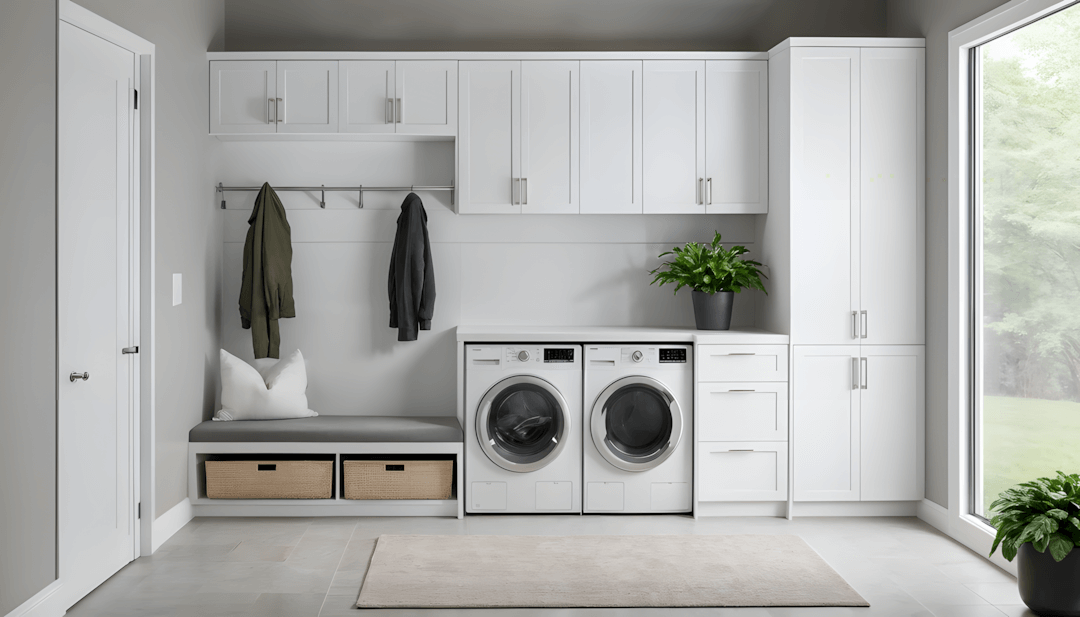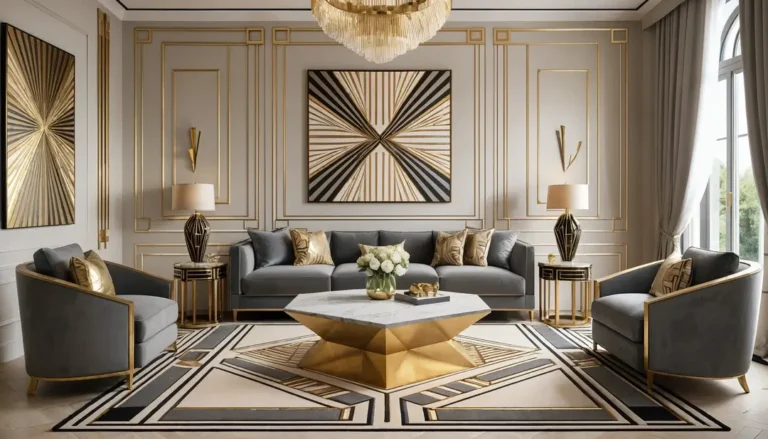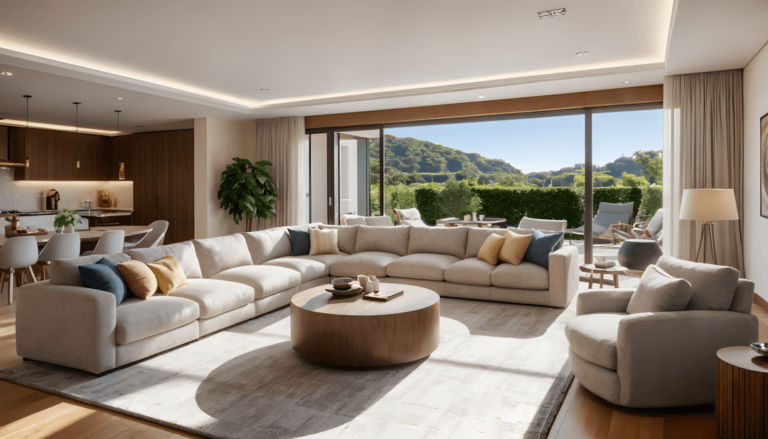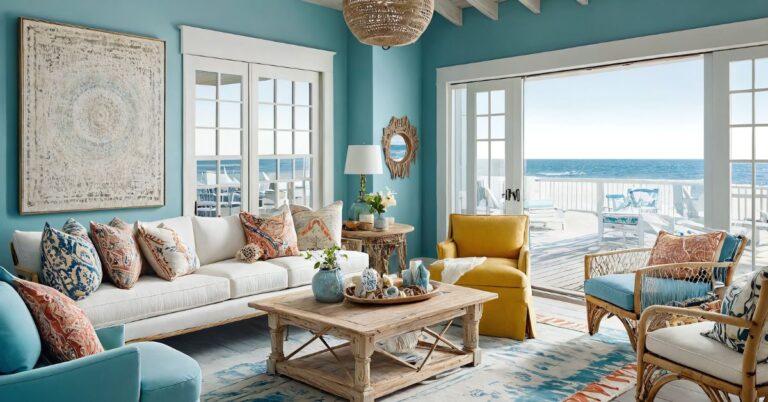In my experience working with homeowners on multi-functional space renovations, I’ve observed that mudroom-laundry room combinations often provide excellent solutions for maximizing utility in limited square footage. Through various projects, I’ve learned that these dual-purpose spaces typically work best when they balance everyday storage needs with laundry functionality while maintaining organized, attractive environments.
Note: For any structural modifications, electrical work, plumbing adjustments, or installations mentioned in this article, always consult with licensed professionals to ensure safety and code compliance.
What makes mudroom-laundry combinations particularly effective is their ability to centralize household organization while keeping messy or utilitarian activities contained in designated areas. I’ve found that homeowners often choose this approach because it typically consolidates daily necessities like coat storage, shoe organization, and laundry processing while creating efficient workflow patterns.
The key to successful mudroom-laundry design often lies in understanding traffic flow, storage priorities, and the relationship between different activities that occur in these spaces. Effective combinations typically accommodate both the quick grab-and-go nature of mudroom use and the longer-duration tasks associated with laundry processing.
Here are 25 approaches for creating functional mudroom-laundry combinations that often work well in different home environments, based on observations from various renovation projects.
1. Farmhouse-Inspired Integration
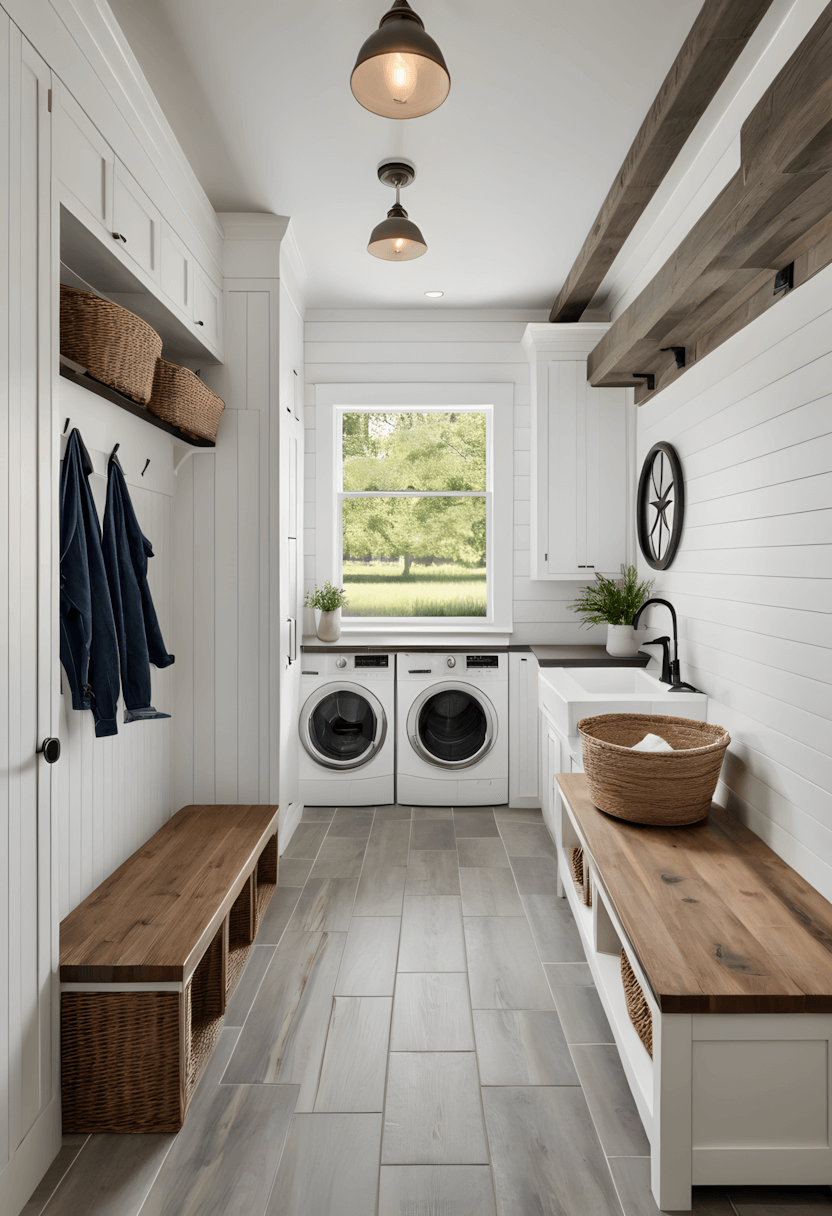
This warm approach often appeals to homeowners wanting welcoming, character-rich spaces. Shiplap walls, rustic benches, and barn doors typically create inviting environments while concealing laundry appliances within custom cabinetry.
Design consideration: Open shelving often provides accessible storage while maintaining the farmhouse aesthetic through natural materials and traditional forms.
Practical benefit: Custom cabinetry often allows appliances to blend seamlessly while providing organized storage for both mudroom and laundry supplies.
2. Compact Colorful Solution
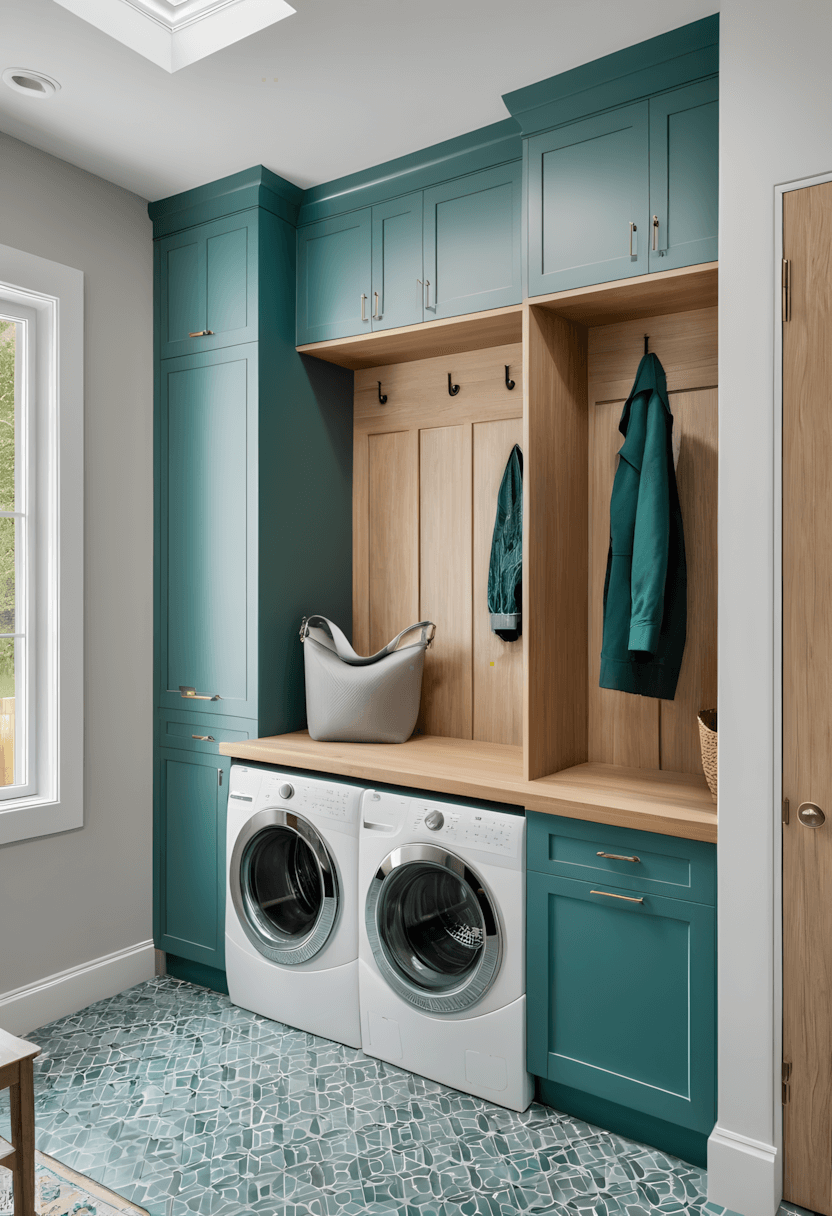
This space-efficient approach often works well for homeowners with limited square footage who want cheerful, energizing environments. Vibrant cabinet colors typically create personality while stackable appliances maximize floor space.
Design strategy: Bright colors often make small spaces feel more intentional and welcoming while providing visual interest in utilitarian areas.
Storage optimization: Combining hooks, benches, and cubbies often accommodates essential mudroom functions within minimal footprint.
3. Scandinavian Simplicity
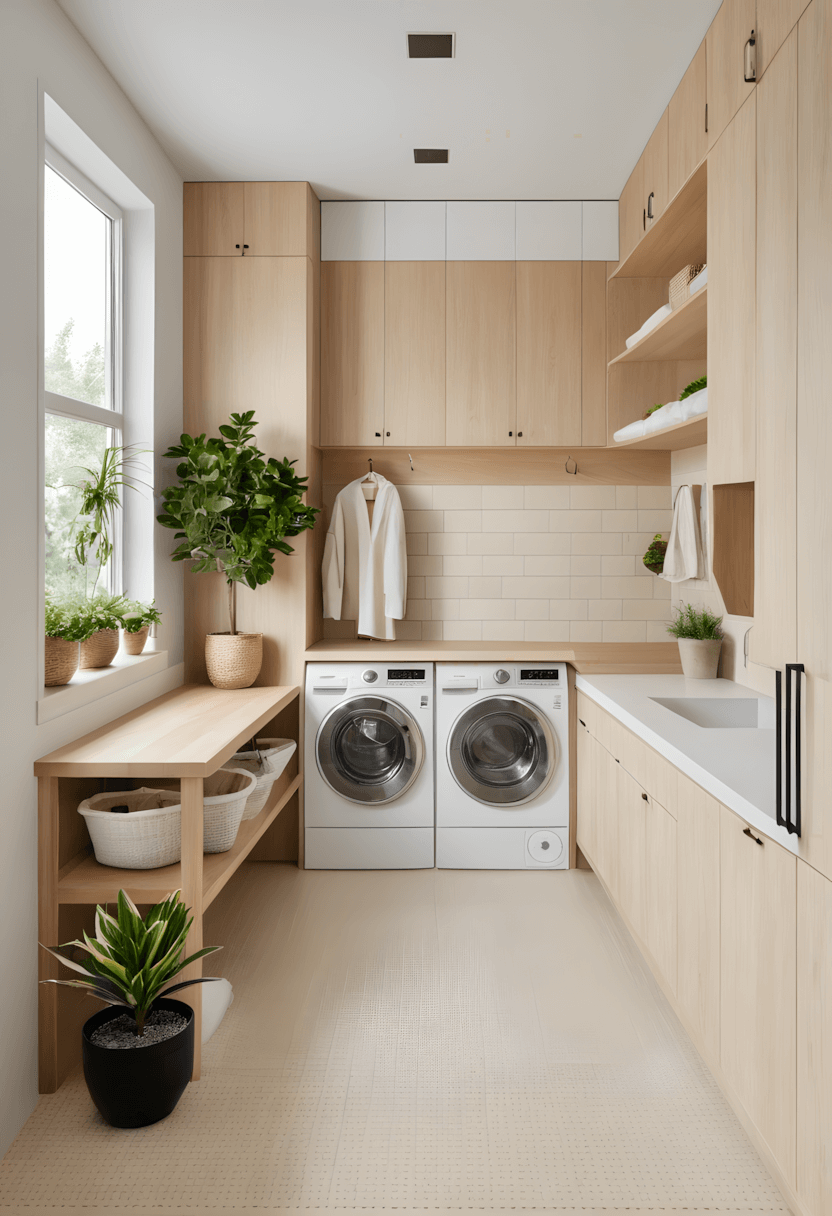
This clean approach often appeals to homeowners preferring uncluttered, functional aesthetics. Light woods, white cabinets, and neutral tones typically create serene environments that feel both organized and welcoming.
Design benefit: Pegboard systems often provide flexible storage that adapts to changing seasonal needs while maintaining visual order.
Material harmony: Light, natural materials often make spaces feel larger while remaining practical for daily use.
4. Concealed Laundry Strategy
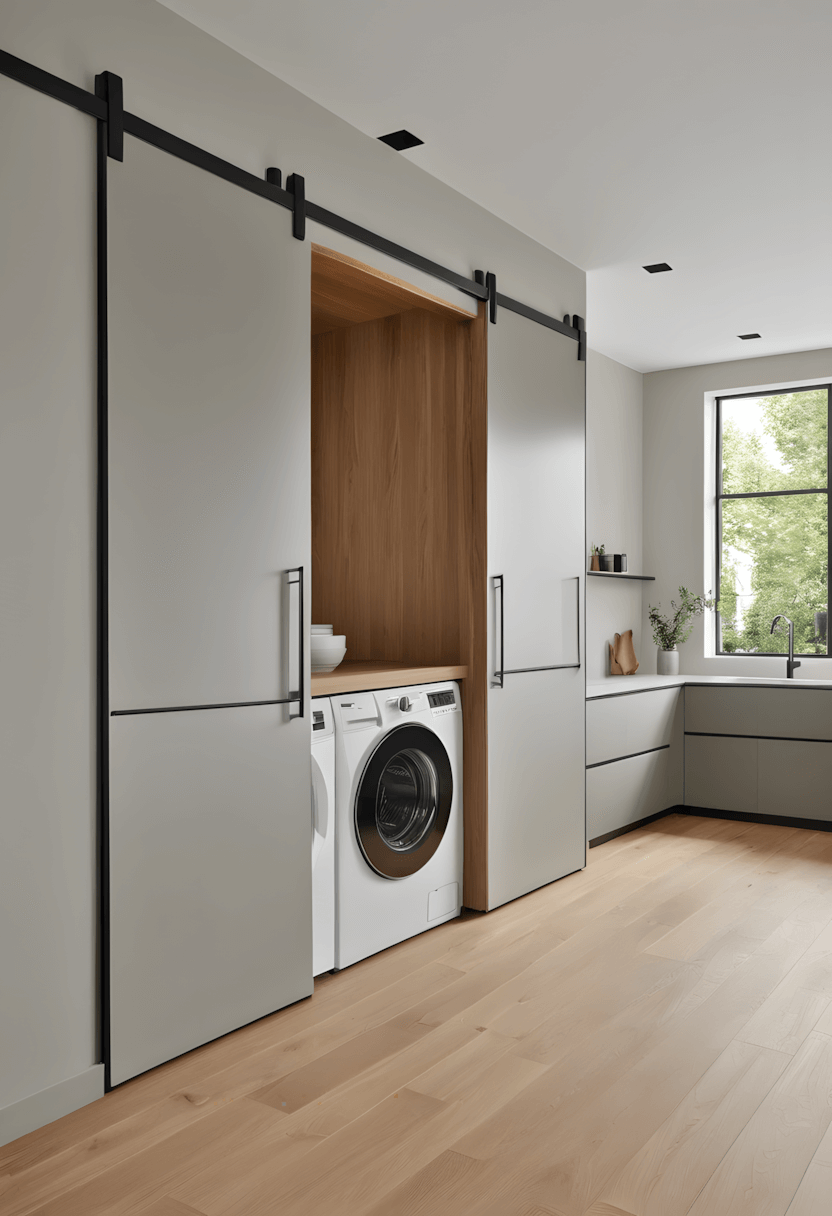
This streamlined approach often works well for homeowners wanting to hide utilitarian elements when not in use. Sliding or pocket doors typically allow laundry areas to disappear while maintaining access when needed.
Design sophistication: Hidden appliances often allow mudroom areas to feel more like intentional living spaces rather than purely functional zones.
Flexibility benefit: Concealment often provides options for entertaining or daily use without visual distraction from laundry equipment.
5. Industrial Character Integration
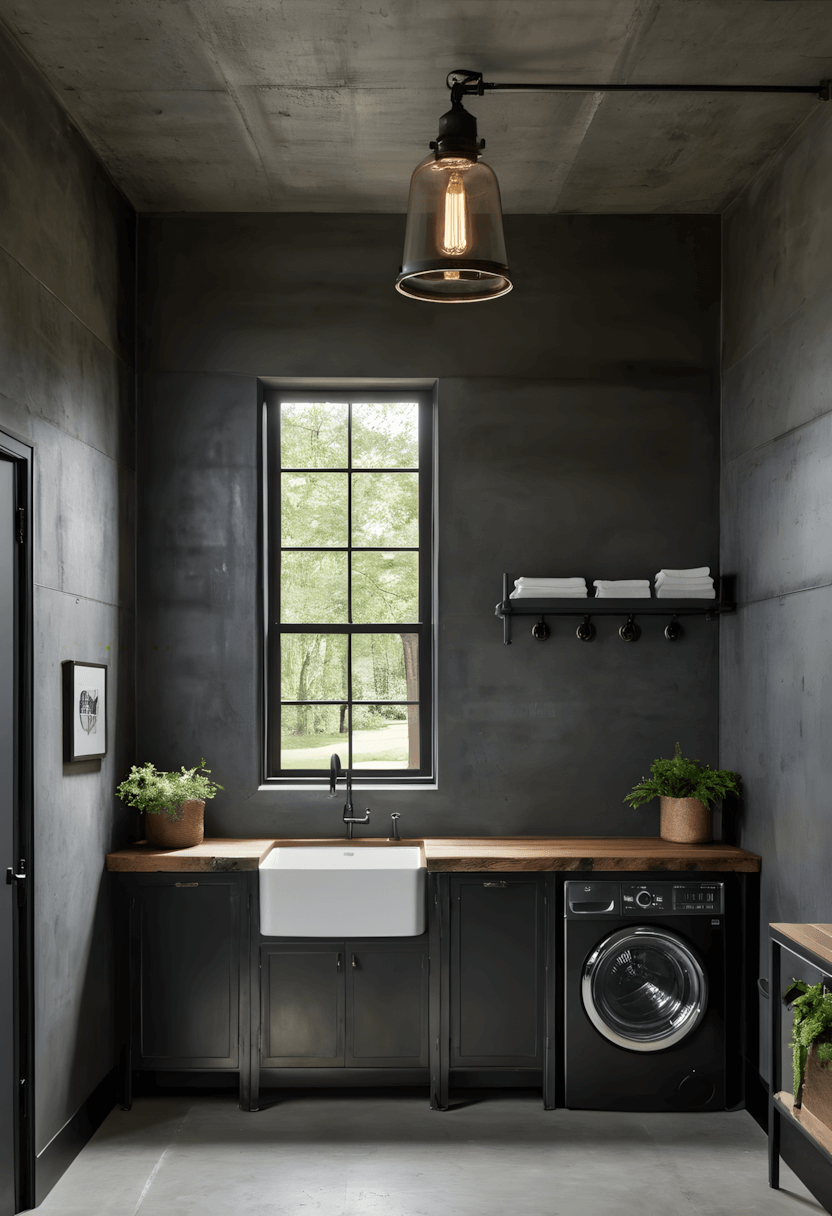
This edgy approach often appeals to homeowners appreciating urban, loft-style aesthetics. Exposed pipes, metal finishes, and reclaimed materials typically create distinctive environments with authentic character.
Design authenticity: Vintage-style utility sinks often add functional workspace while contributing to the industrial aesthetic.
Material coordination: Raw materials often provide durability while creating cohesive design themes that feel intentional rather than purely functional.
6. Space-Maximizing Efficiency
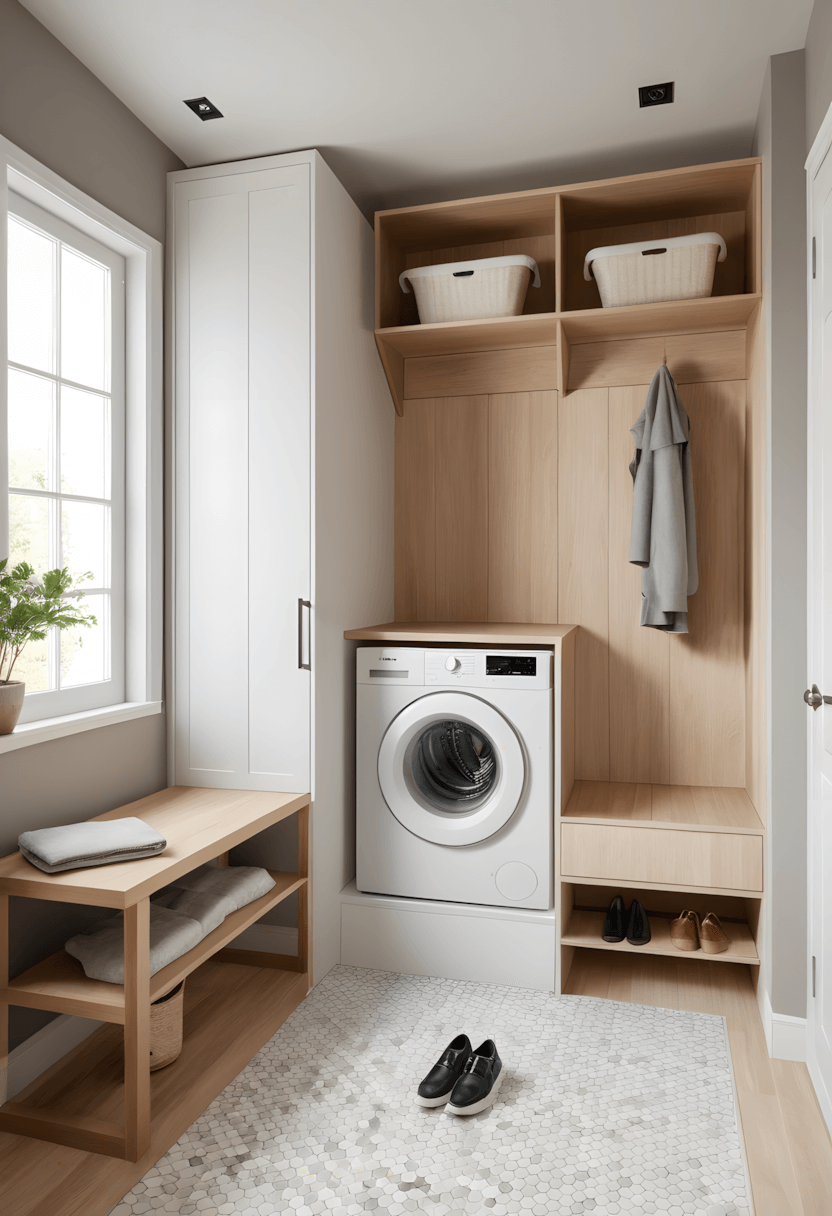
This optimization approach often works well for homeowners with severe space constraints. Wall-mounted solutions and fold-down surfaces typically provide functionality without permanent space commitment.
Design innovation: Multi-functional furniture often serves dual purposes while maintaining compact storage when not needed.
Lighting strategy: Proper illumination often makes small spaces feel larger while ensuring tasks can be completed safely and efficiently.
7. Elegant Neutral Foundation
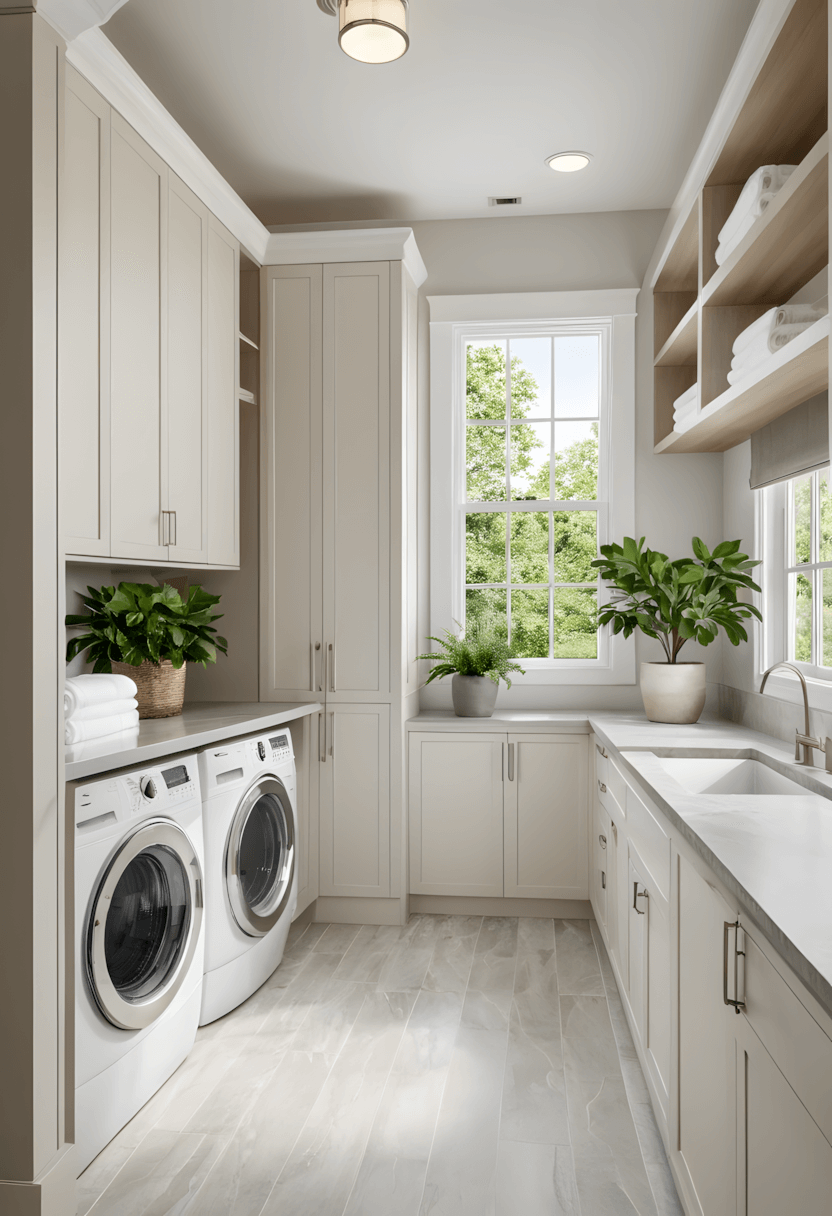
This sophisticated approach often appeals to homeowners wanting refined, timeless environments. Soft neutrals typically create calm atmospheres while quality fixtures add understated luxury.
Design benefit: Neutral palettes often provide flexibility for seasonal decorating changes while maintaining sophisticated foundations.
Material selection: Brushed metals and quality finishes often elevate utilitarian spaces while remaining practical for daily use.
8. High-Contrast Modern
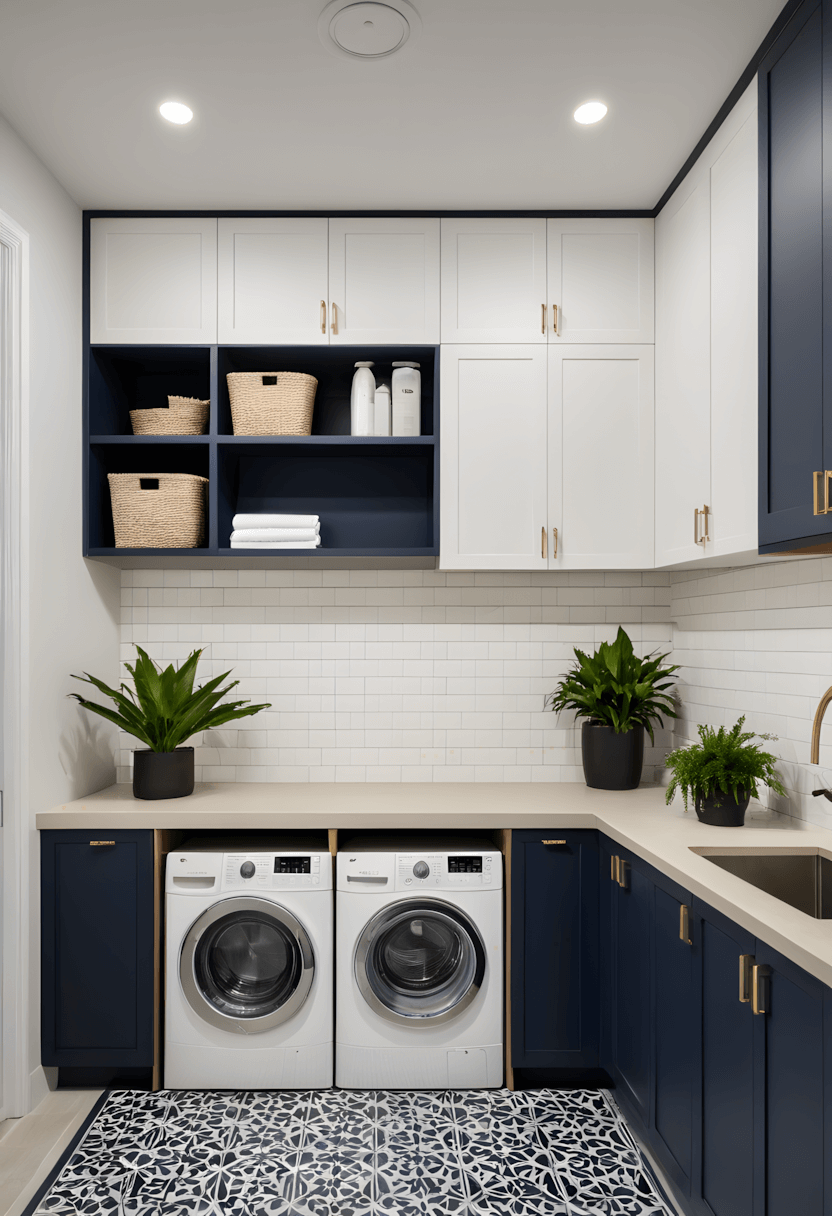
This dramatic approach often works well for homeowners wanting bold, contemporary statements. Dark cabinetry with light countertops typically creates striking visual impact while maintaining functionality.
Design balance: Bright accents often prevent high-contrast schemes from feeling too stark while adding personality and visual interest.
Contemporary appeal: This approach often feels current and intentional while providing the drama some homeowners prefer.
9. Rustic Character Development
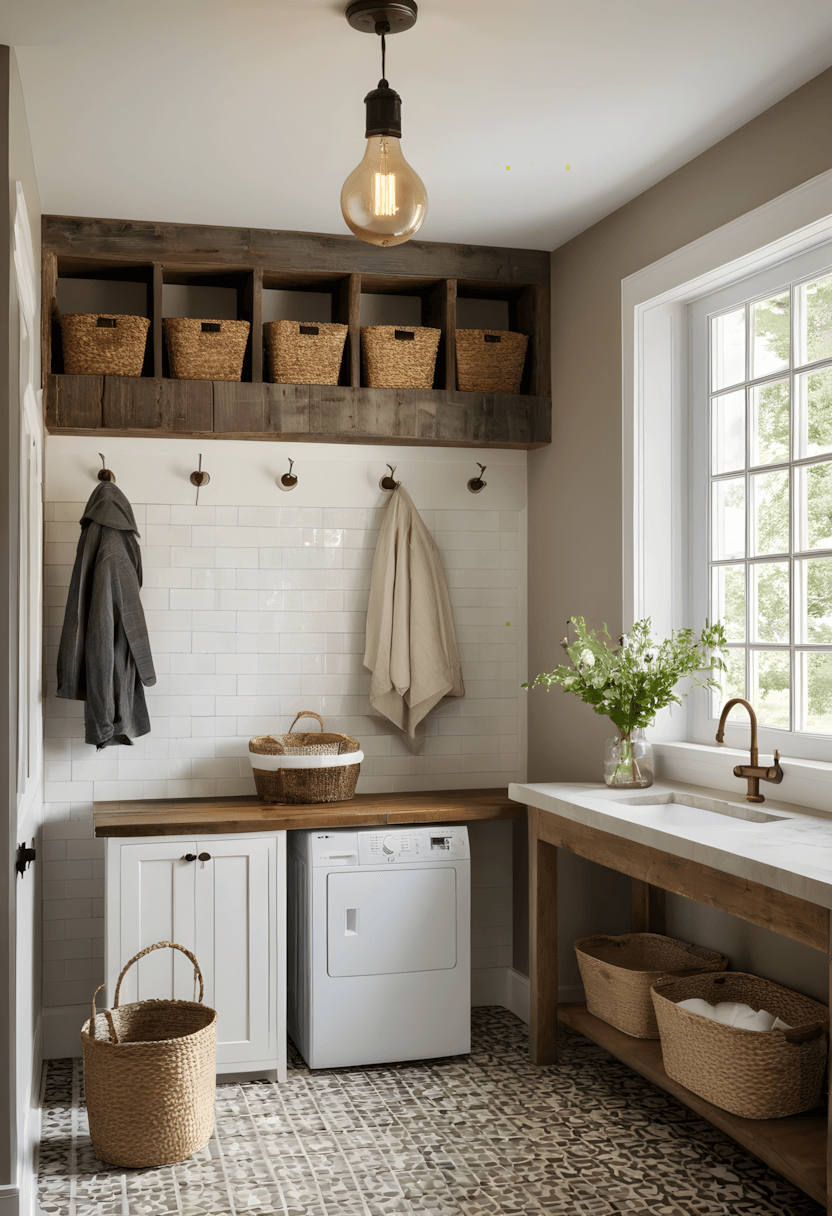
This warm approach often appeals to homeowners wanting cozy, authentic environments. Reclaimed materials and weathered finishes typically create welcoming spaces that feel established and comfortable.
Design authenticity: Wire baskets and vintage hardware often add genuine character while providing practical storage solutions.
Material patina: Weathered surfaces often hide everyday wear while developing character that improves spaces over time.
10. Clean White Sophistication
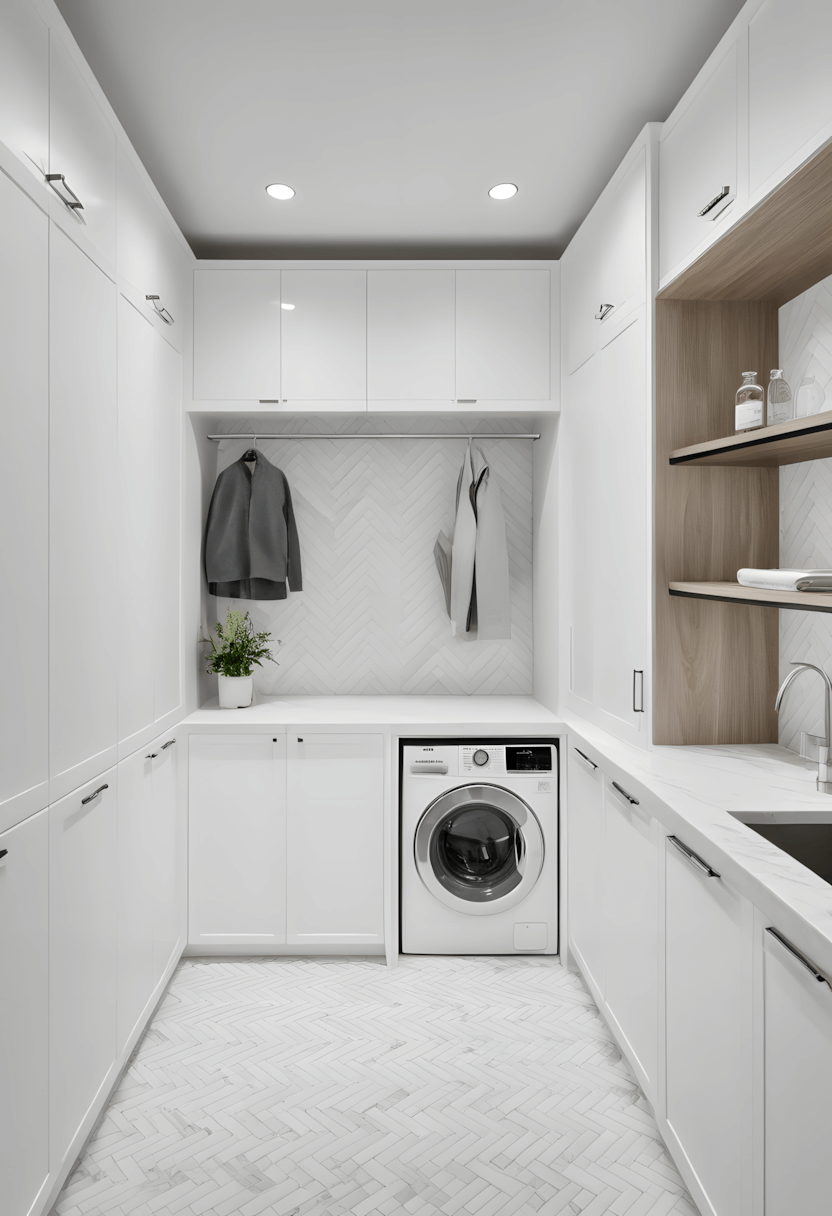
This crisp approach often works well for homeowners preferring timeless, clean aesthetics. All-white schemes typically create fresh environments while textural elements prevent sterility.
Design technique: Varied textures in similar colors often provide visual interest while maintaining the clean, unified appearance.
Practical consideration: White surfaces often require more maintenance but provide the bright, clean feeling many homeowners desire.
11. Pet-Accommodating Design
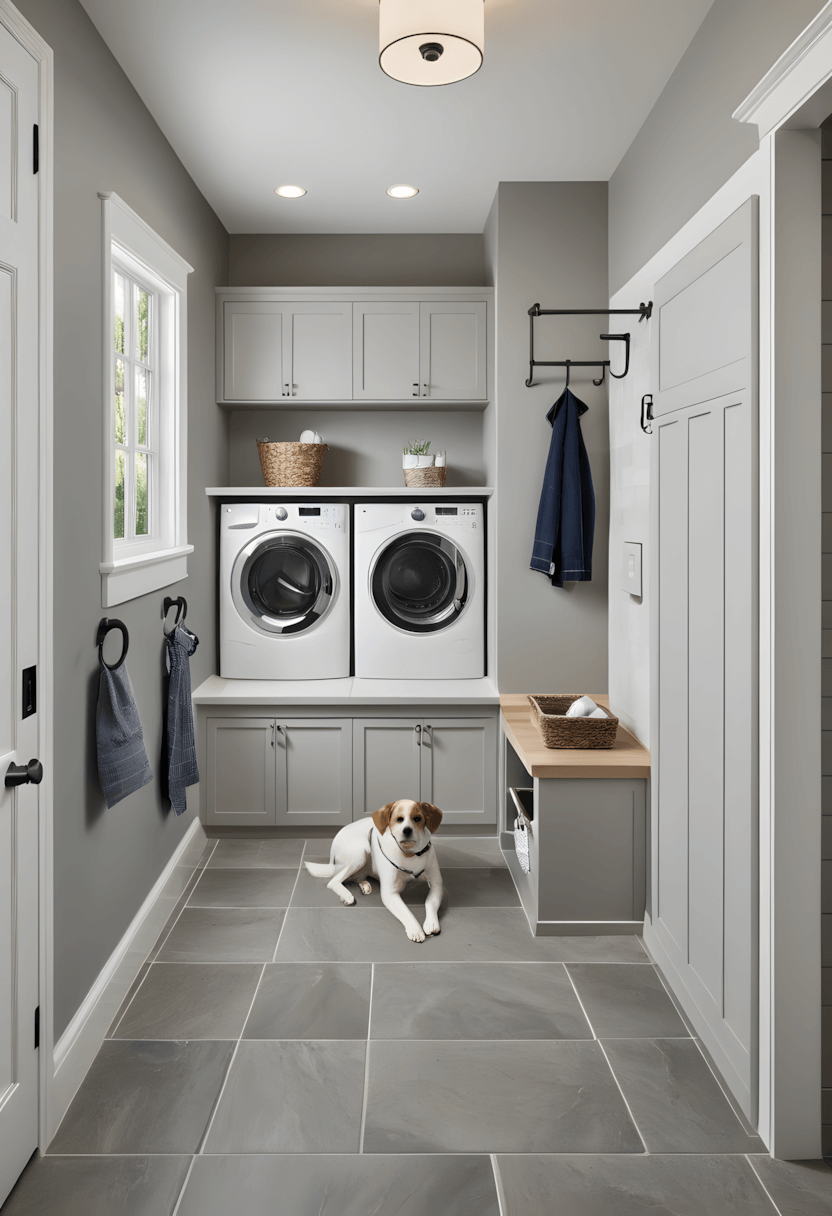
This specialized approach often appeals to pet-owning homeowners wanting dedicated care and cleanup areas. Built-in pet stations typically provide convenient grooming and supply storage.
Practical integration: Pet washing stations often work well when positioned near laundry sinks for water access and drainage.
Material durability: Tile flooring and washable surfaces often become essential for managing pet-related cleanup efficiently.
12. Coastal-Inspired Freshness
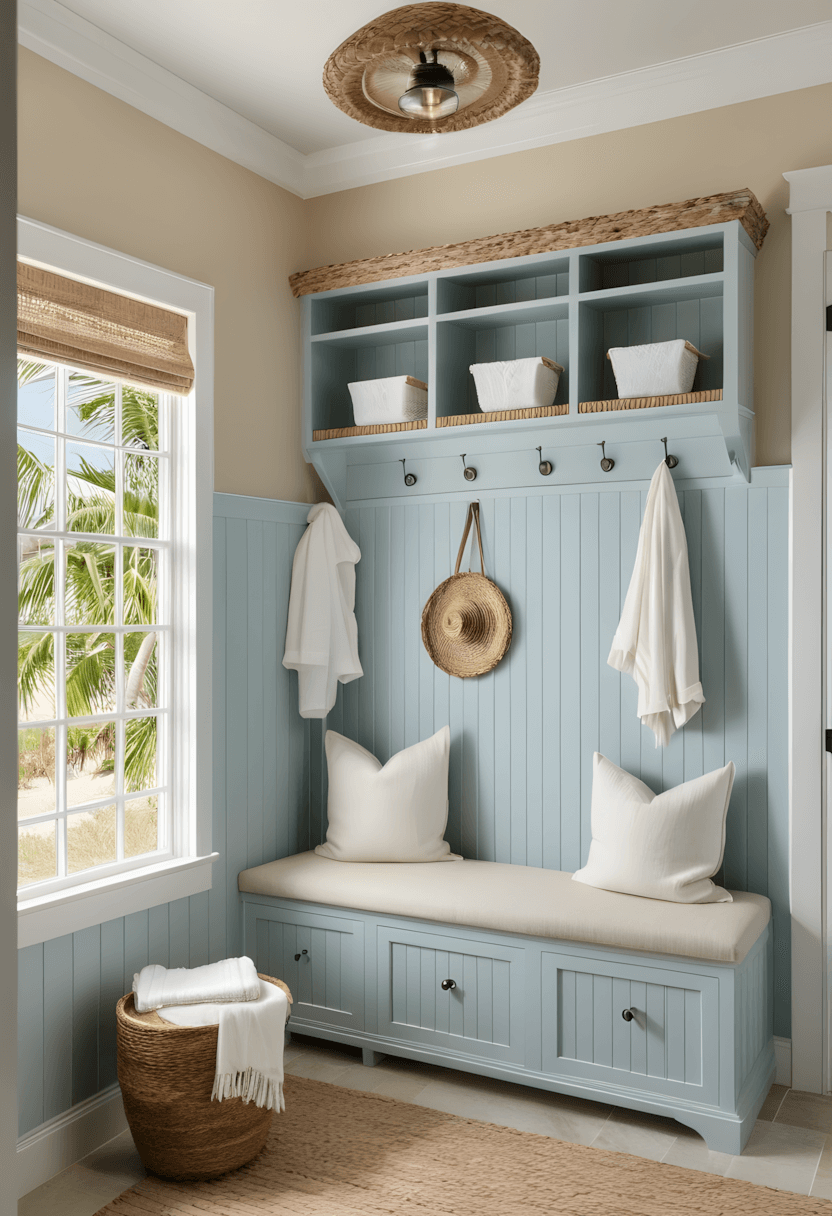
This breezy approach often works well for homeowners wanting relaxed, vacation-inspired environments. Light blues, sandy tones, and natural materials typically create refreshing atmospheres.
Design harmony: Coastal accessories often enhance the theme while providing functional storage and organizational benefits.
Color psychology: Light, airy colors often make spaces feel larger and more pleasant for daily tasks.
13. Statement Floor Focus
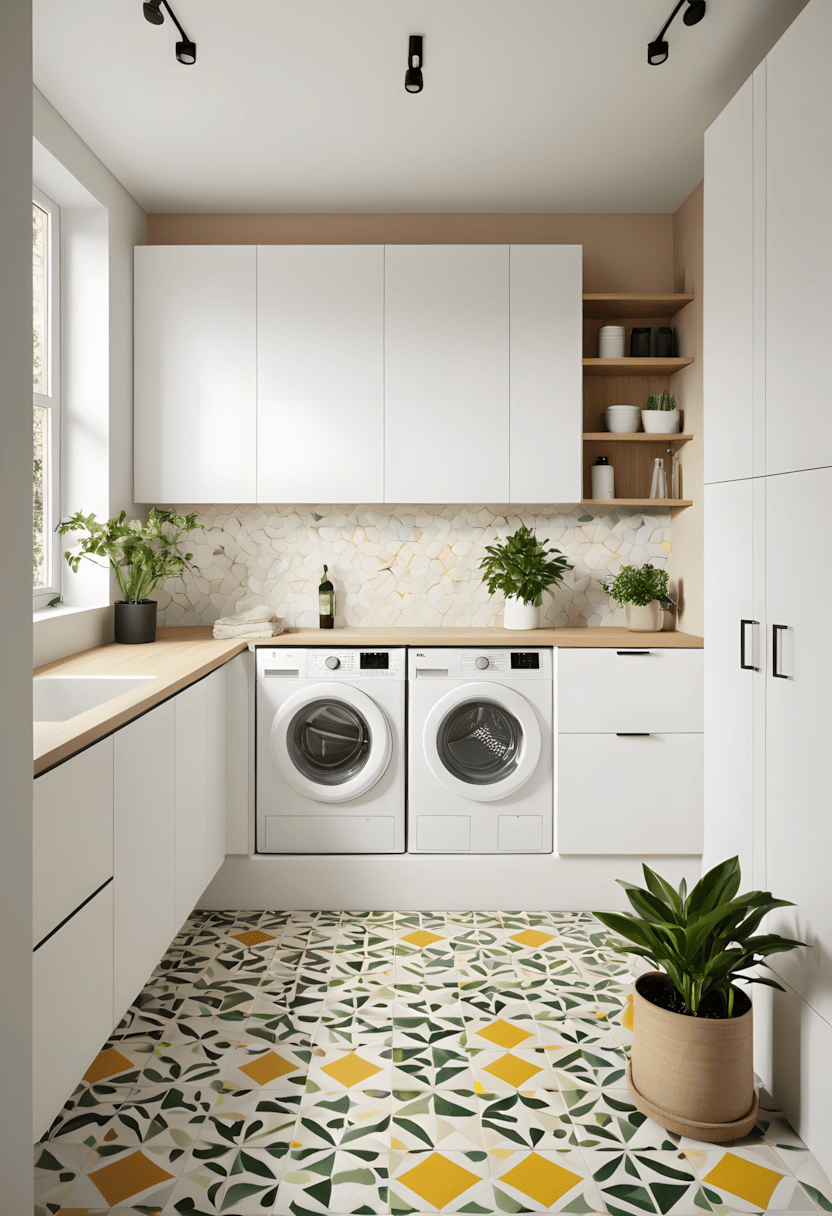
This bold approach often appeals to homeowners wanting dramatic focal points. Patterned or colorful tile flooring typically creates visual interest while providing practical, easy-to-clean surfaces.
Design balance: Bold floors often work best with understated walls and cabinetry to prevent overwhelming the space.
Practical benefit: Decorative tiles often hide dirt and wear while providing the durability necessary for high-traffic areas.
14. Multi-Level Functionality
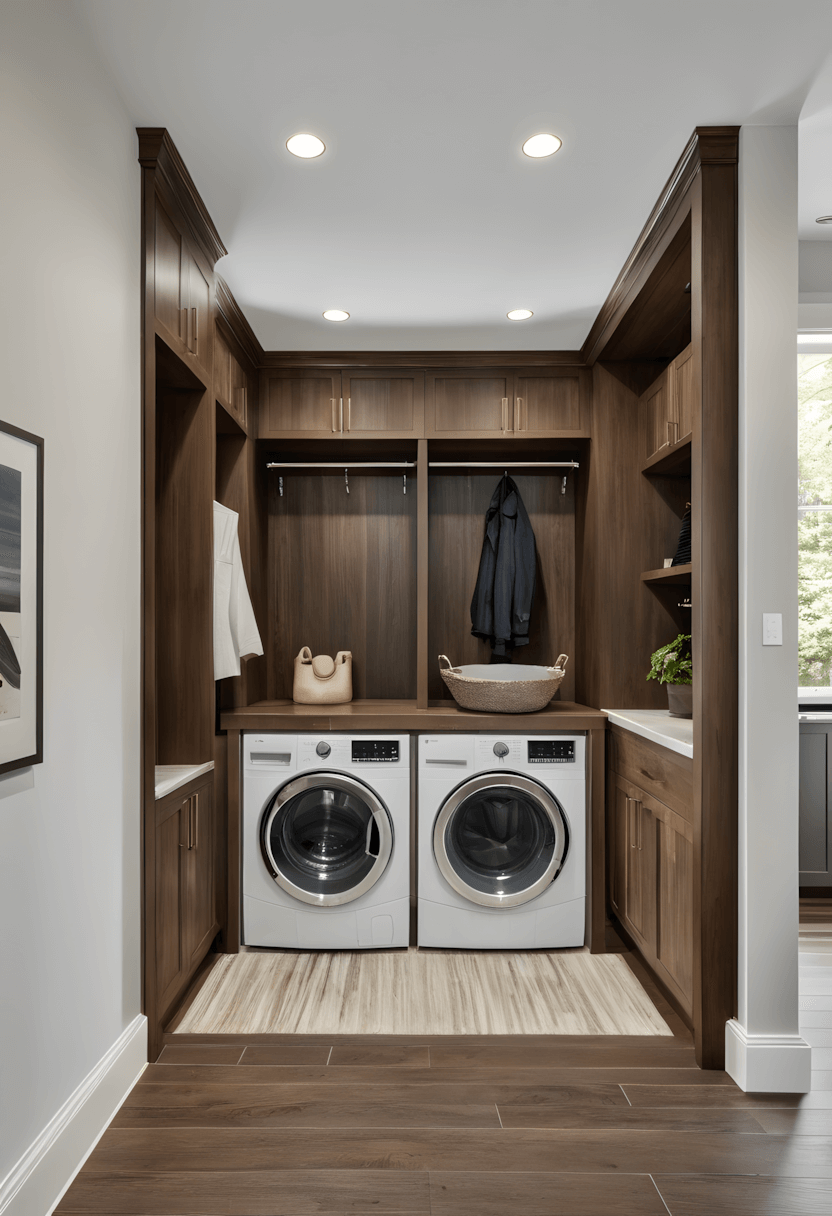
This organizational approach often works well for homeowners with architectural features that create natural zones. Different levels typically allow for clear separation between mudroom and laundry activities.
Design advantage: Level changes often create natural organization while improving workflow efficiency.
Space utilization: Multi-level designs often maximize storage and functionality within existing architectural constraints.
15. Luxury Material Integration
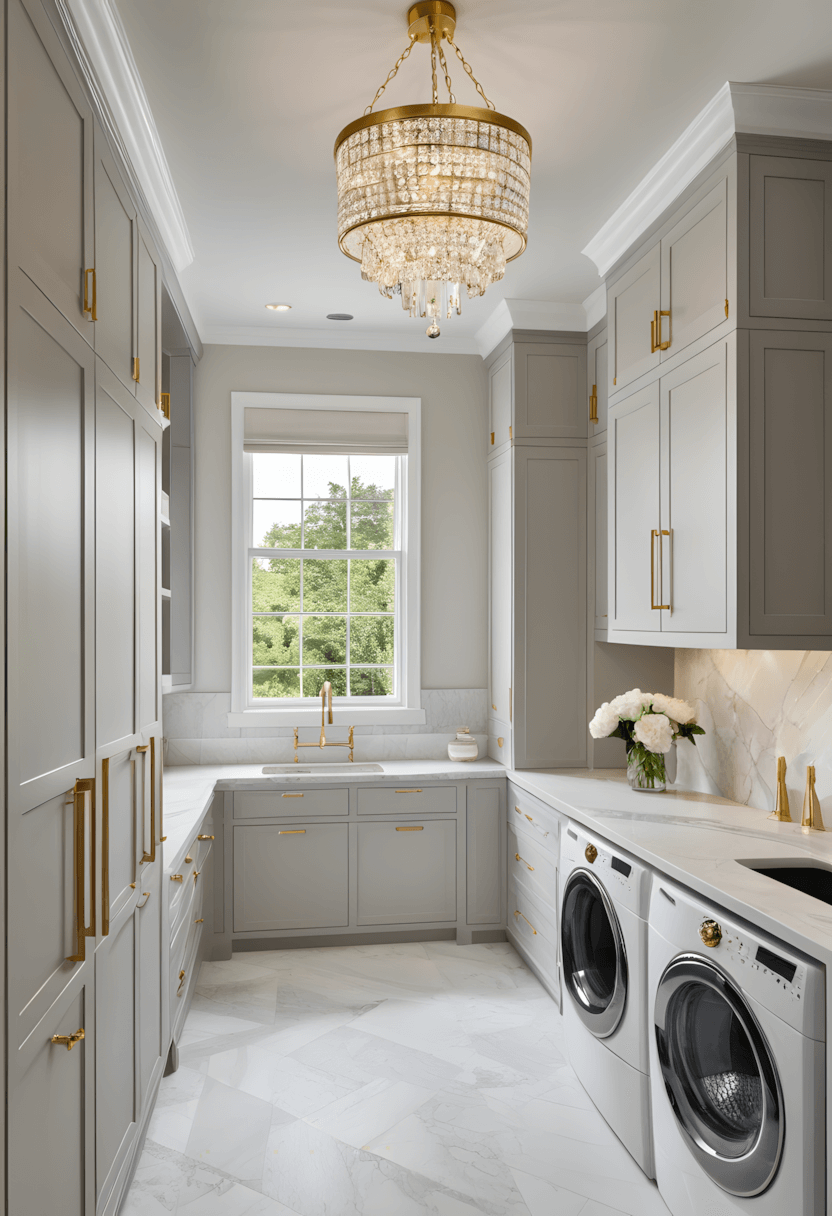
This upscale approach often appeals to homeowners wanting sophisticated, high-end environments. Marble surfaces and metallic fixtures typically create elegant atmospheres while maintaining functionality.
Design sophistication: Quality materials often elevate utilitarian spaces while providing durability and long-term value.
Organization benefit: Glass containers and elegant storage often make everyday supplies appear more intentional and attractive.
16. Vintage Character Development
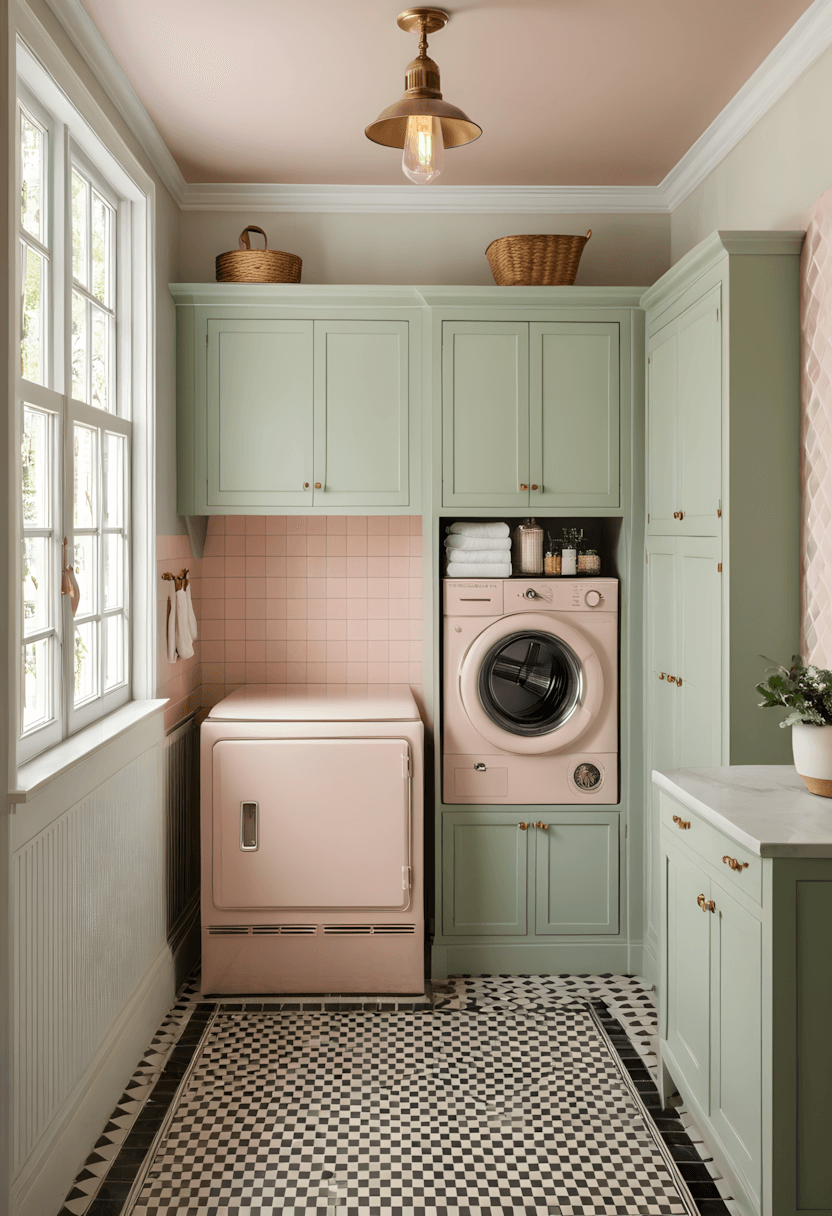
This nostalgic approach often works well for homeowners appreciating period charm and authentic details. Retro appliances and vintage fixtures typically create unique, characterful environments.
Design authenticity: Period-appropriate elements often provide genuine charm that cannot be replicated through modern imitations.
Color consideration: Traditional color schemes often enhance vintage appeal while remaining practical for contemporary use.
17. Living Plant Integration
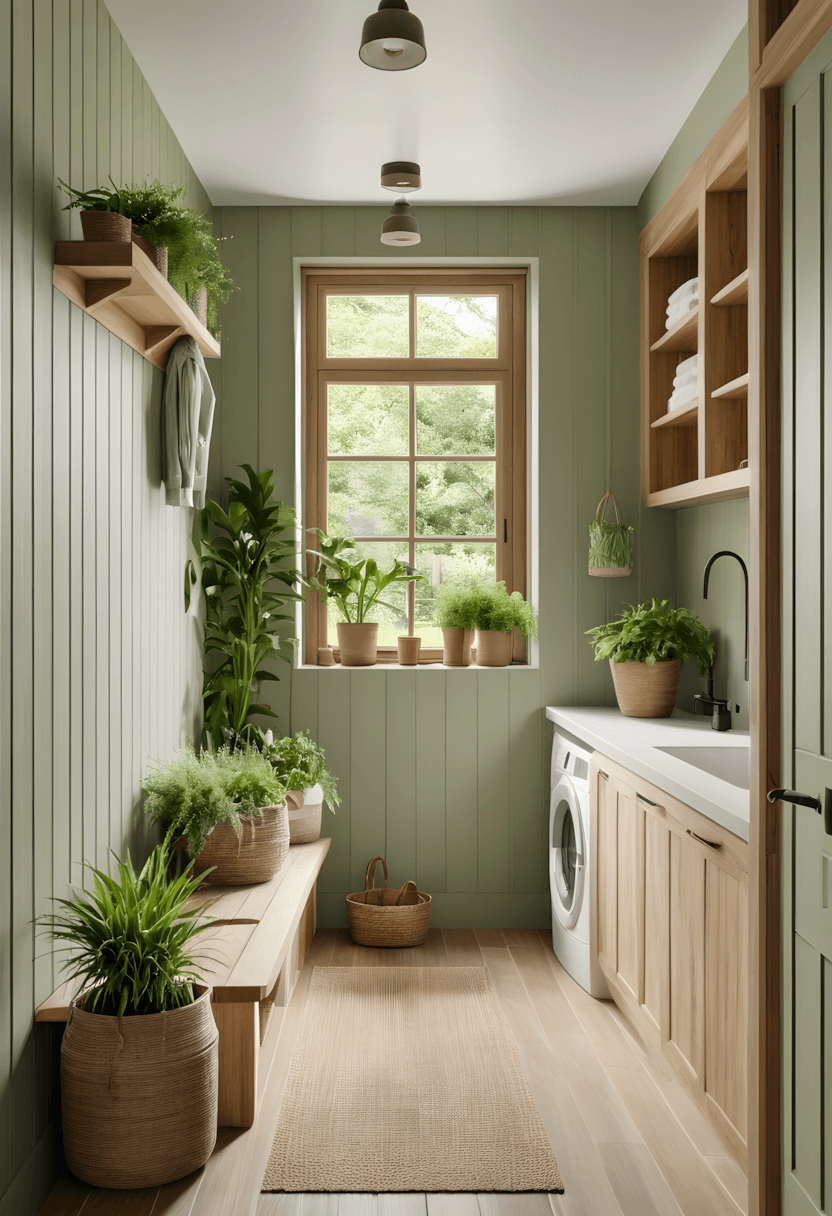
This organic approach often appeals to homeowners wanting to soften utilitarian spaces with natural elements. Plants typically add life and freshness while improving air quality.
Design benefit: Greenery often makes functional spaces feel more welcoming while providing natural air purification.
Practical consideration: Plant selection often needs to consider humidity levels and available light in laundry areas.
18. Hallway Conversion Strategy
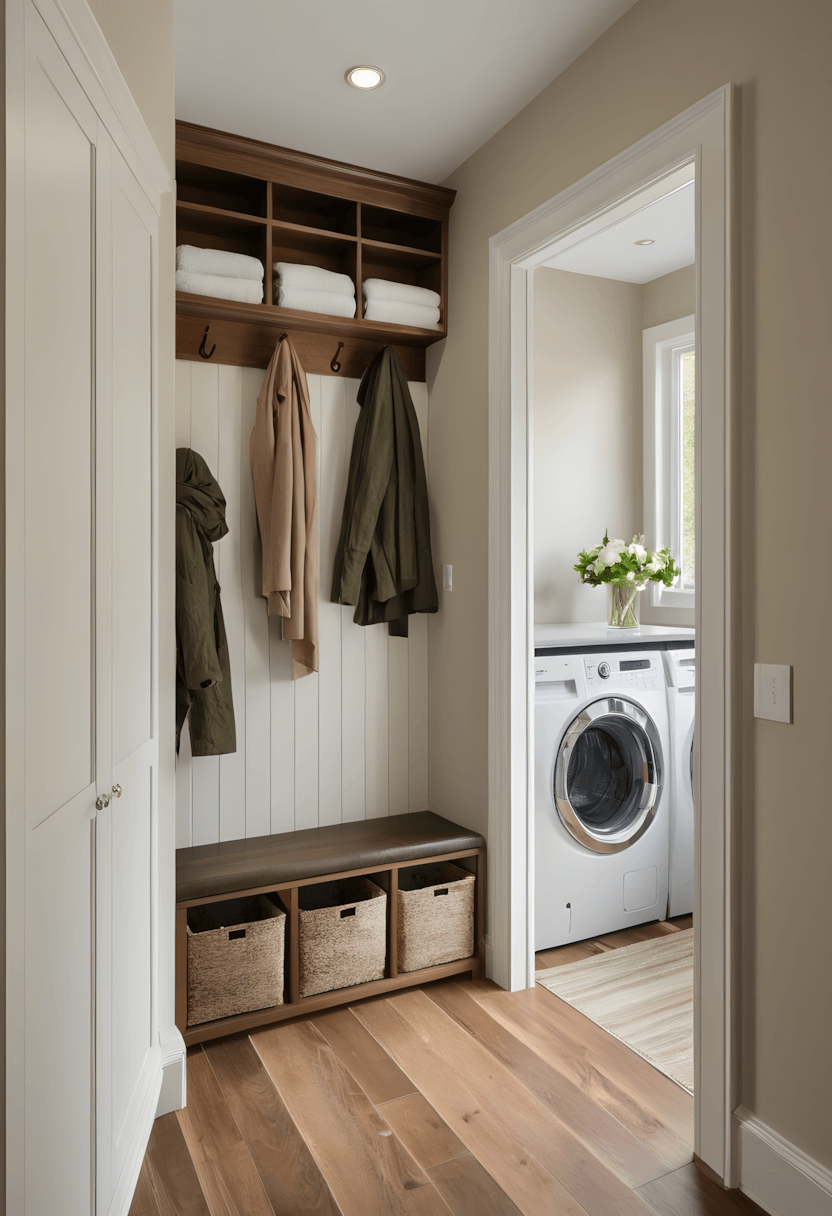
This adaptive approach often works well for homeowners with long, narrow spaces. Built-in storage and appliance integration typically transform underutilized hallways into functional zones.
Design challenge: Narrow spaces often require careful planning to ensure adequate clearance for both storage access and traffic flow.
Efficiency benefit: Hallway locations often provide convenient access while keeping utilitarian functions out of main living areas.
19. Sleek Contemporary Design
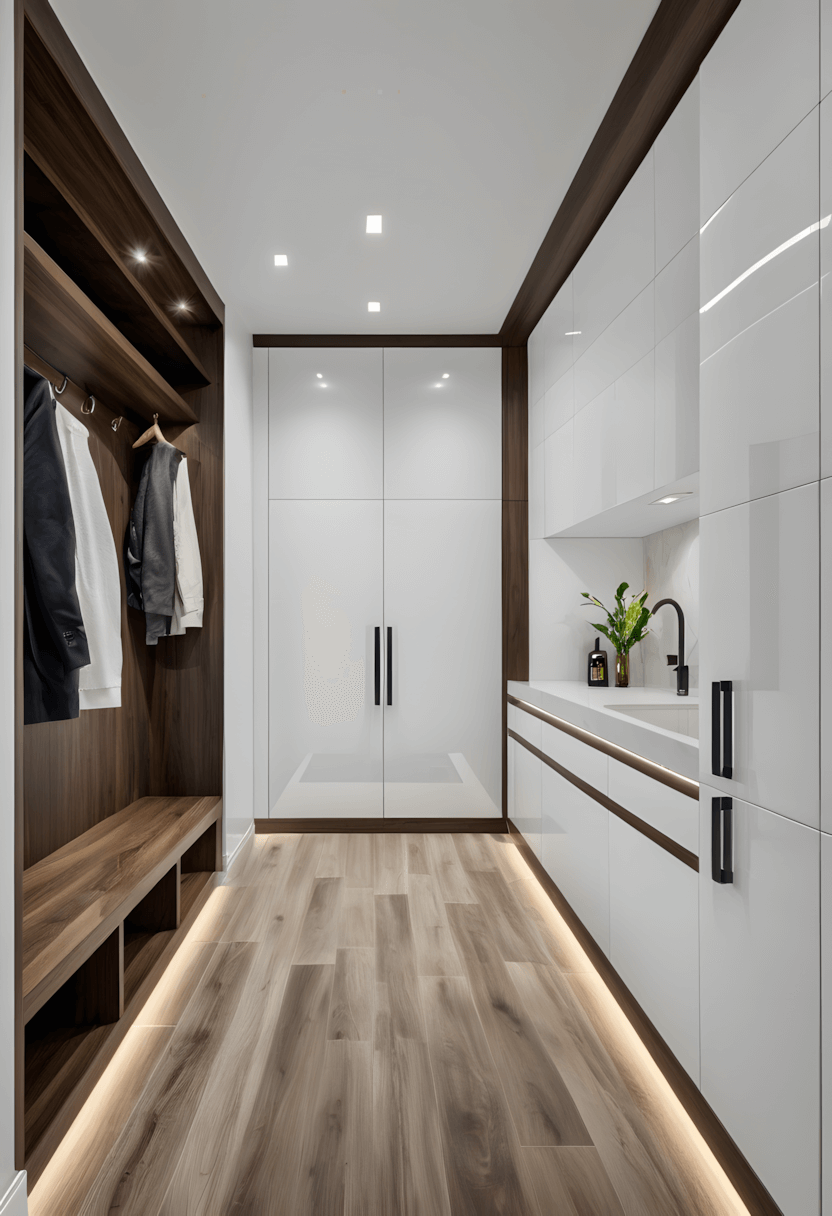
This modern approach often appeals to homeowners wanting cutting-edge, minimalist aesthetics. Handle-free cabinets and integrated lighting typically create seamless, sophisticated environments.
Design cohesion: High-gloss finishes often create unified appearances while remaining practical for frequent cleaning.
Technology integration: Contemporary designs often accommodate modern conveniences while maintaining clean visual lines.
20. Monochromatic Texture Play
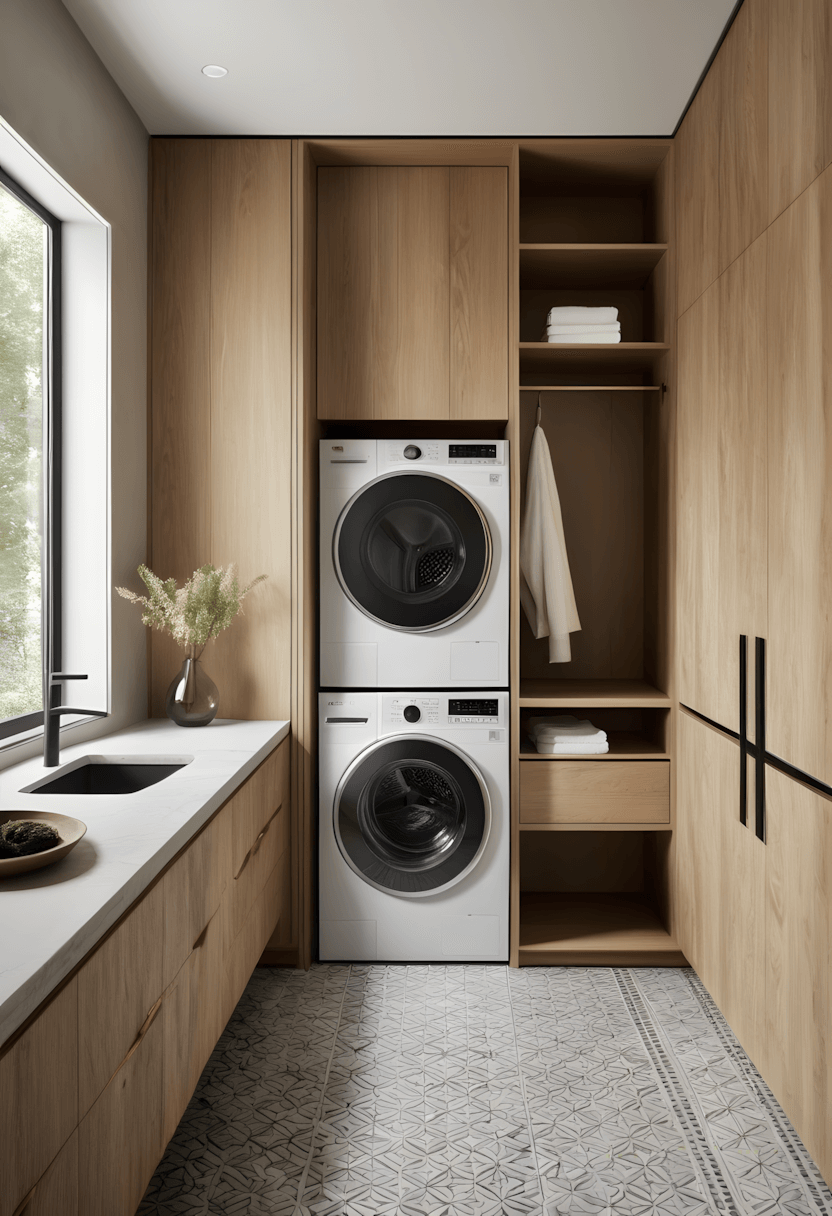
This sophisticated approach often works well for homeowners wanting visual interest without color complexity. Varied textures in similar hues typically create depth while maintaining unified appearances.
Design technique: Mixing matte and glossy finishes often adds sophistication while keeping color schemes simple and timeless.
Visual cohesion: Monochromatic schemes often create calm environments while texture variation prevents monotony.
21. Statement Wallpaper Integration
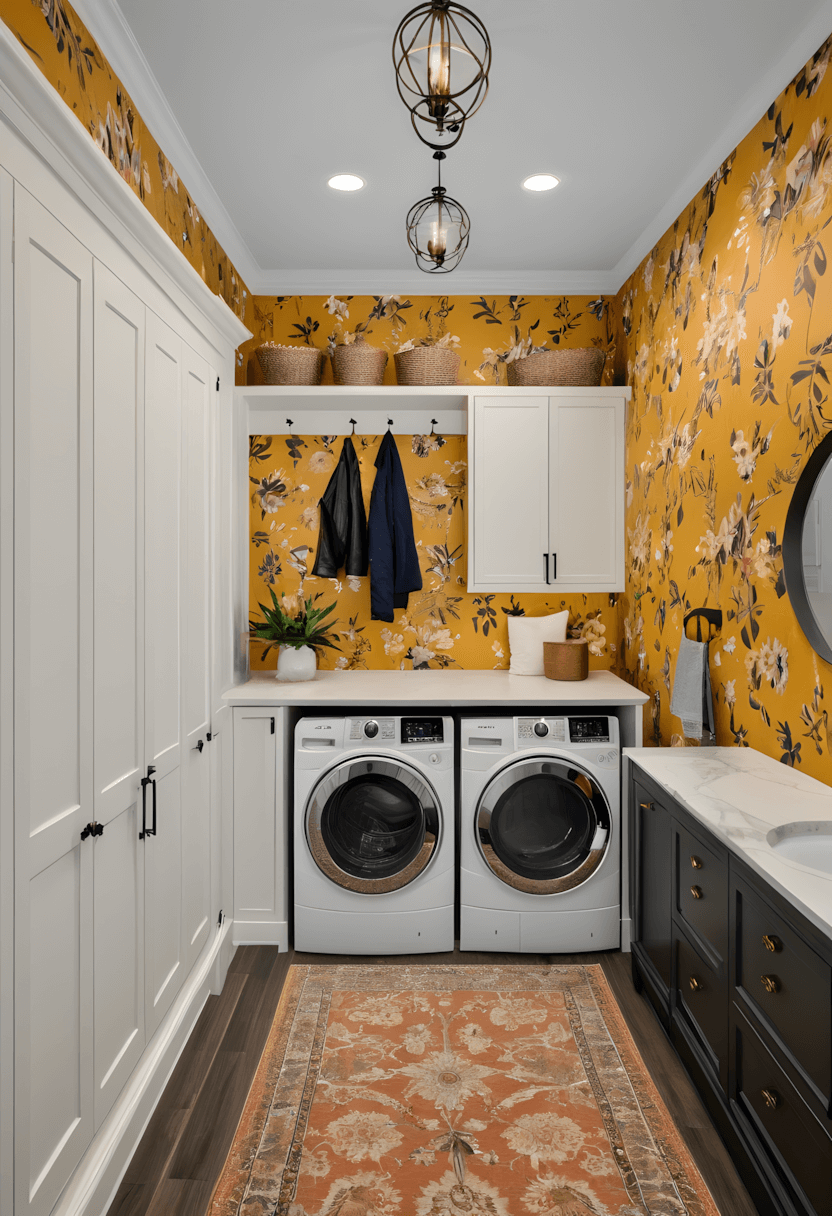
This bold approach often appeals to homeowners wanting to add personality through pattern and color. Dramatic wallpapers typically create focal points while neutral cabinetry provides balance.
Design balance: Bold backdrops often work best when furniture and fixtures remain simple to avoid visual competition.
Personality expression: Wallpaper often allows for individual creativity while maintaining functional space requirements.
22. Custom Built-In Solutions
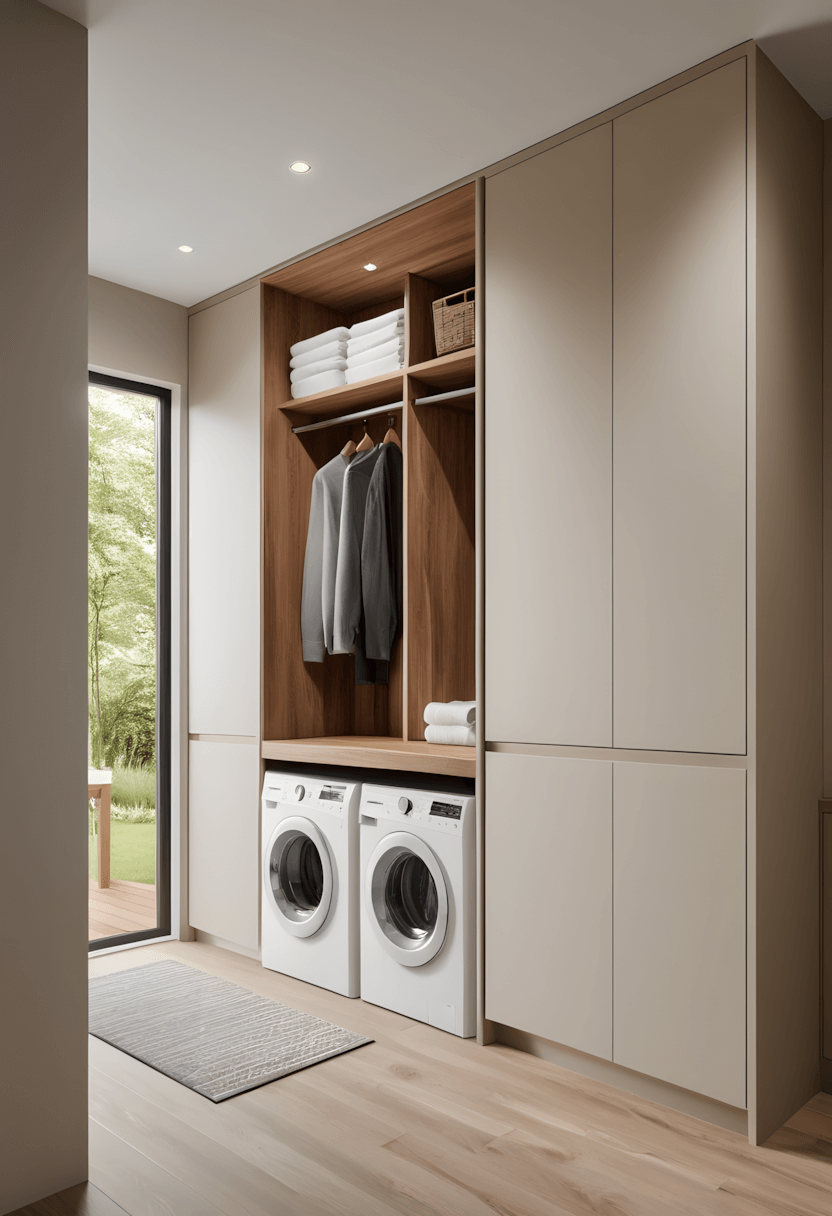
This tailored approach often works well for homeowners with specific storage and functional needs. Custom elements like pull-out hampers and hidden ironing boards typically maximize space efficiency.
Design optimization: Built-ins often provide superior space utilization compared to standard furniture solutions.
Investment value: Custom work often provides lasting functionality while adding to home value through improved organization.
23. Natural Light Optimization
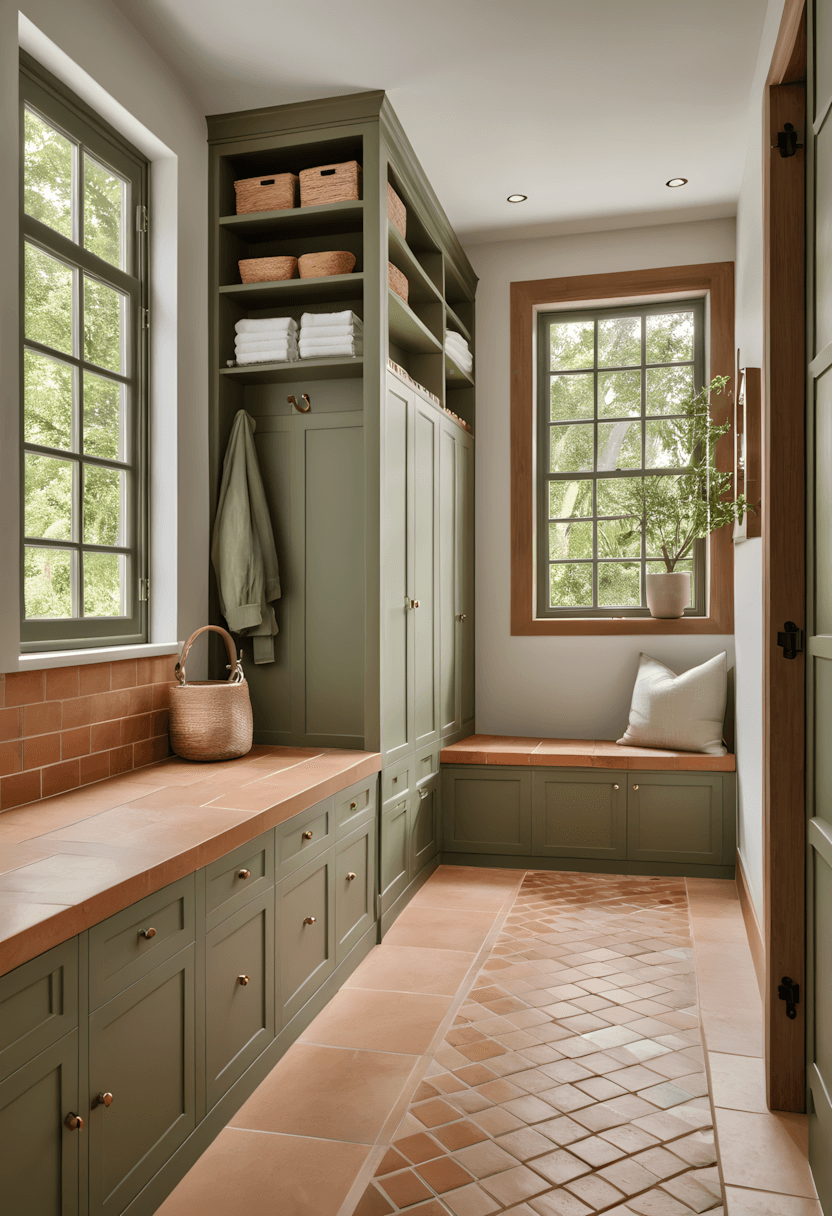
This bright approach often appeals to homeowners wanting to create pleasant, energy-efficient environments. Earthy tones with abundant natural light typically create welcoming, grounded atmospheres.
Design benefit: Natural light often makes spaces feel larger and more pleasant while reducing energy costs.
Color harmony: Earth tones often complement natural light beautifully while creating warm, inviting environments.
24. Transparent Storage Strategy
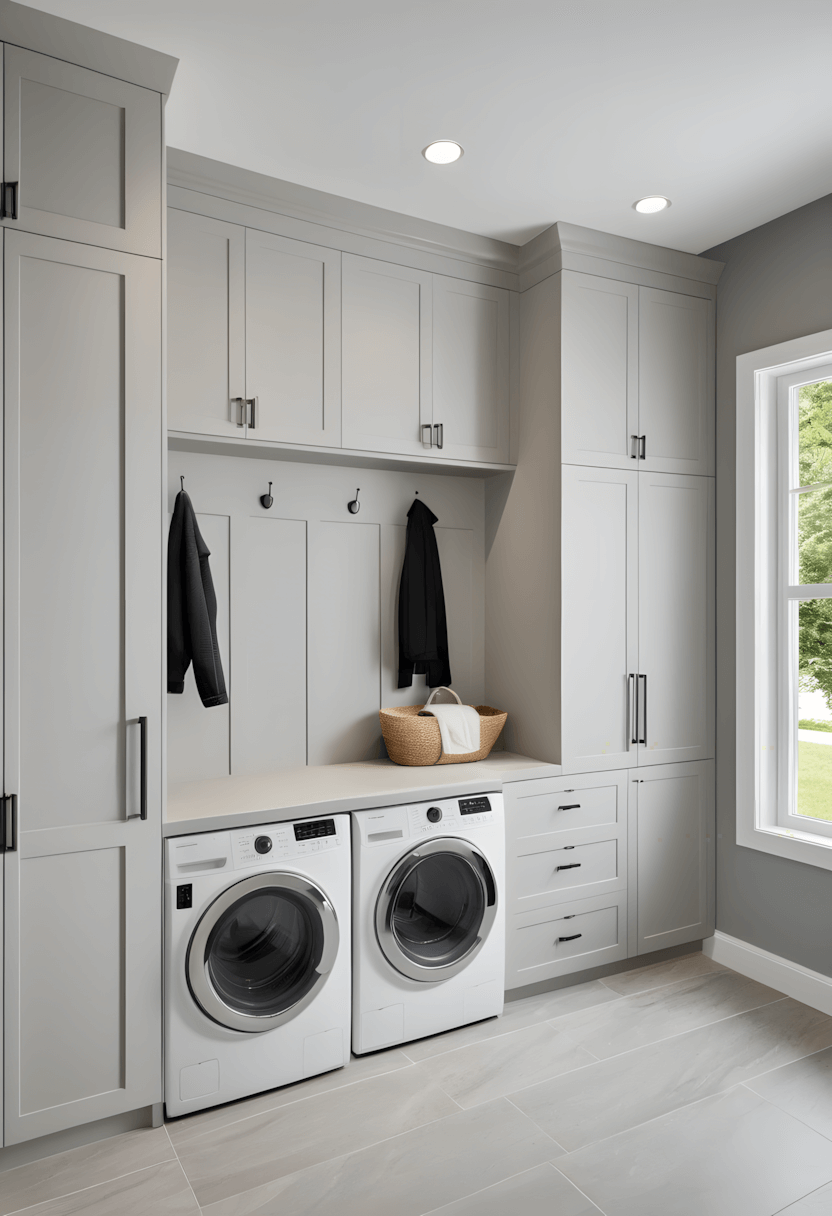
This open approach often works well for homeowners wanting to display organized supplies attractively. Glass doors and open storage typically create airy feelings while maintaining accessibility.
Design sophistication: Visible organization often requires more maintenance but creates intentional, curated appearances.
Practical consideration: Open storage often works best when contents remain consistently organized and visually appealing.
25. Family-Friendly Functionality
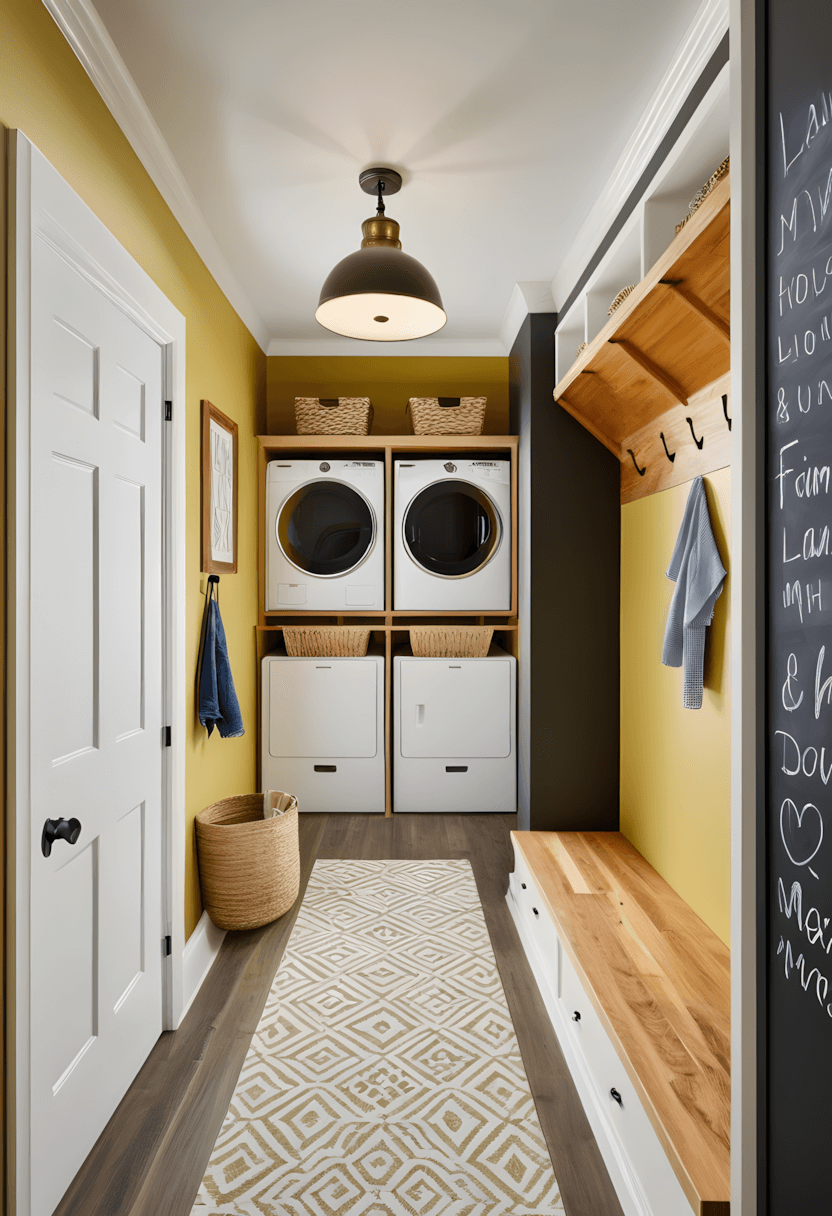
This inclusive approach often appeals to homeowners with children who want spaces that accommodate all family members. Interactive elements and colorful organization typically create engaging, functional environments.
Design consideration: Durable materials and easy-to-clean surfaces often become essential for active family use.
Organizational strategy: Child-height storage and visual organization systems often encourage family participation in maintaining order.
Workflow Planning for Combination Spaces
Through various projects, I’ve observed that successful mudroom-laundry combinations often depend on understanding the different activity patterns each function requires. Mudroom use typically involves quick transitions and grab-and-go access, while laundry often requires longer-duration activities and workspace.
Effective layouts often consider peak usage times and potential conflicts between simultaneous activities to ensure spaces work efficiently for all family members during busy periods.
Ventilation and Moisture Control
Combination spaces often require particular attention to ventilation and moisture management due to the mix of wet outdoor items and laundry activities. Proper ventilation often becomes crucial for preventing mold, mildew, and odor problems while maintaining comfortable environments.
Consider factors such as exhaust fans, moisture-resistant materials, and air circulation when planning these dual-purpose spaces to ensure long-term functionality and comfort.
Storage Strategy Development
Successful mudroom-laundry combinations often require thoughtful storage planning that accommodates both seasonal variations and daily necessities. Effective storage typically includes solutions for coats and shoes, laundry supplies, cleaning materials, and seasonal items while maintaining easy access to frequently used elements.
The most effective storage systems often adapt to changing family needs while maintaining organized, attractive appearances that encourage consistent use and maintenance.
Remember: For any electrical work, plumbing modifications, or structural changes related to mudroom-laundry combination projects, always consult with licensed professionals to ensure proper installation and code compliance.

